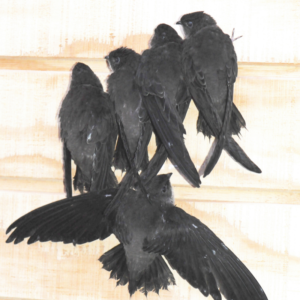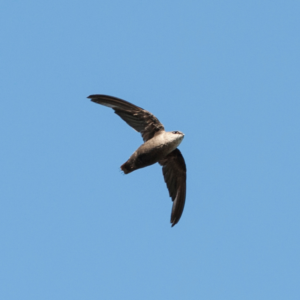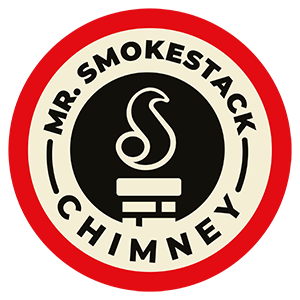Have you been hearing the sounds of birds chirping in your chimney? It’s probably not your imagination. In fact, it’s not at all uncommon for birds to set up camp in your flue in hopes of staying warmer and safer from predators. And one of the most notorious for invading this space is the chimney swift.
What Are Chimney Swifts?
Chimney swifts are often described as small, dark gray or brown birds with cigar-shaped bodies. Their heads are round, they have short necks and tails, and their bills are wide and small. They also spend most of their time airborne, even bathing in flight! They simply glide down into the water, hit the surface, then fly back up, shaking off the water as they go.
 As far as nesting, chimney swifts have a long history of nesting in hollow trees. They cannot perch horizontally, like most birds can on a branch or rooftop, so these vertical walls lend the perfect spot to settle in. If they try to do anything else, they’ll simply fall to the ground.
As far as nesting, chimney swifts have a long history of nesting in hollow trees. They cannot perch horizontally, like most birds can on a branch or rooftop, so these vertical walls lend the perfect spot to settle in. If they try to do anything else, they’ll simply fall to the ground.
How do they build a nest on a vertical surface? Well, chimney swifts saliva is glue-like, meaning they can easily attach a bed of leaves and twigs to surfaces like your chimney, creating a convenient little cavern for their young.
Unfortunately, in more recent decades as land is settled and developed, many of these hollow trees have been cut down, leaving swifts without suitable environments to build their homes. But this hasn’t stopped them from finding a good alternative to their former nesting places. Instead, they’ve started to invade our chimneys.
Unfortunately, while many types of birds can be removed and relocated, allowing you to enjoy your chimney worry-free for the rest of the season, this tactic doesn’t apply to the chimney swift. Chimney swifts are endangered and therefore protected by the Migratory Bird Treaty Act. This means that it is illegal to remove these birds and/or their eggs and young while they are living inside of your chimney.
So, what’s there to do? Fortunately for folks throughout Raleigh and The Triangle, the staff here at Mr. Smokestack Chimney Service has many years of experience with dealing with chimney swifts. We can give you advice on how to best deal with these birds if they’re in your chimney and how to prevent them from coming back again down the line.
It’s Official – Swifts Are In My Chimney! What Do I Do Now?
As we mentioned above, these birds are protected by federal law, so you cannot have them or their young removed from your chimney. In fact, doing so could land you with some pretty hefty fines! In addition, you cannot schedule chimney services or light a fire. The birds must simply be left alone.
Does this mean you’re stuck with them forever? Not at all! When fall arrives, these birds will instinctively leave their nests to spend the winter in South America. That said, this may take up to 90 days, so it will take some patience on your part.
Fortunately, there are some bright sides to hosting these creatures. While there, they can actually help your family out by eating the bugs that can cause so much irritation during the summer months. In fact, they’re known for eating 12,000 flying insects – including mosquitoes, termites, biting flies and gnats – per day!
Homeowners can also rest assured that chimney swifts will not damage the chimney in any way. And if the noises of these birds are bothering you, you shouldn’t have to put up with it for too long. The loudest sounds typically come from the baby birds as they are being fed by their parents, and within a couple of weeks, they’ll be old enough to feed themselves – meaning the constant tweeting should stop.
Did one of the birds happen to fall into the fireplace? Simply pick it up gently and place it back on the wall of the chimney.
Eventually, the chimney swifts will leave on their own, and you’ll have your chimney back to enjoy for the rest of the season. But because chimney swifts tend to return to the same nesting spots year after year, investing in professional care to keep them out for good is imperative.
OK, They’re Gone… Now What?
Before the chimney swifts leave for winter, they don’t pick up after themselves as most houseguests might. In fact, they typically leave behind quite a bit of nesting materials, along with droppings and other debris in your chimney. These materials can clog your flue, causing smoke and harmful fumes to enter your home, and they’re also a fire hazard.
 Because of this, scheduling a chimney sweeping before starting your burning season is a must. A sweeping will ensure you aren’t left facing dangerous scenarios when you light your first fire of the year, and it will also clear all evidence of the birds’ presence, leaving them less likely to return to the same spot next year. Just be sure to mention to your sweep that chimney swifts were there previously, so they know exactly what they’re working with.
Because of this, scheduling a chimney sweeping before starting your burning season is a must. A sweeping will ensure you aren’t left facing dangerous scenarios when you light your first fire of the year, and it will also clear all evidence of the birds’ presence, leaving them less likely to return to the same spot next year. Just be sure to mention to your sweep that chimney swifts were there previously, so they know exactly what they’re working with.
Another really important step to take is having a well-fitted chimney cap professionally installed. A chimney cap goes right over the top of the chimney, preventing all kinds of unwanted material from entering the flue, and it’s the best defense against critters of all kinds – including small birds like the chimney swift.
You’ll also want to ensure your cap has sides of metal mesh screening. Make sure the mesh is small enough to keep birds and animals out while still large enough for any hazardous by-products of combustion to exit your chimney. In the end, a chimney cap is a fairly inexpensive, yet very effective way of keeping these birds out.
Mr. Smokestack Chimney Service is proud to sell and install a wide variety of caps, and we can show you which ones are the most successful at keeping these birds out.
Can I Help Chimney Swifts?
Now, some wonder what happens to the birds if they have no nesting options upon their return, whether that’s in tree form or chimney form. If you’re concerned, there are lots of guides online for building a chimney swift tower on your property! This simple structure is similar to a chimney and may attract the birds, so that they have a safe place to nest that is well away from the comfort of your home.
It’s also important to stay educated on chimney swifts and be sure to educate your friends, family, and neighbors, as well. The more people that can recognize and protect them, the safer they’ll stay in the years ahead!
Call Today for Quality Care
Ready to invest in the quality chimney care you deserve? The crew at Mr. Smokestack would love to help you out with it all. Give us a call today to book your next appointment!
